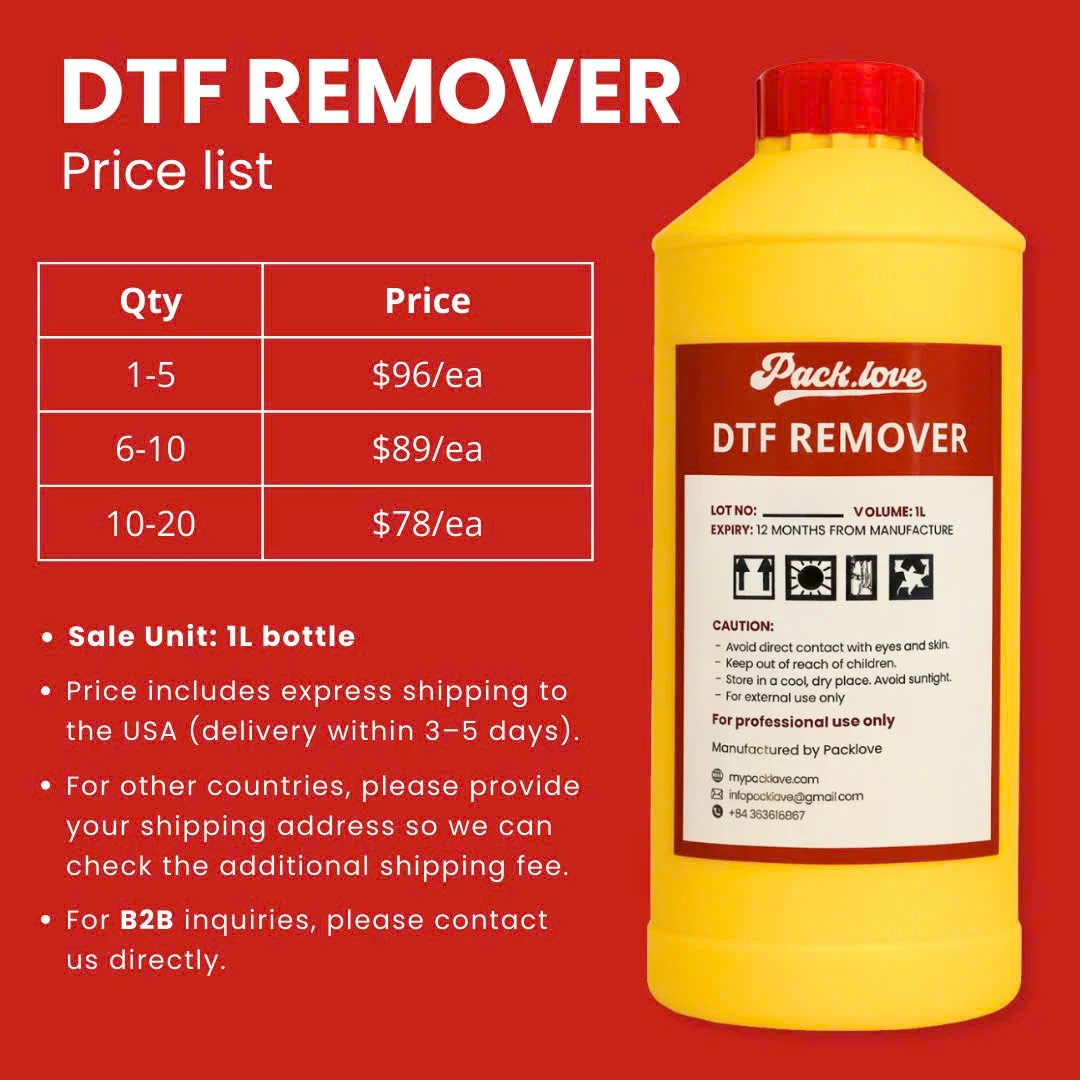What Is A Yoke In Clothing? Complete Guide And Examples
Many people encounter the term ‘yoke’ in discussions about clothing but may be unsure of its exact meaning. This article clearly explains what a yoke is in a garment, exploring its purpose, common examples, and different types in an accessible way.
Simply put, a yoke is a shaped piece of fabric in a garment, typically found around the neck and shoulders, or at the top part of a skirt or pants, where it provides support. This component is crucial for a garment’s fit and overall appearance. Understanding such clothing terminology enhances appreciation for garment construction, and the yoke is a key element in this process.
1. The purpose of a yoke: more than just fabric
A yoke does more than just add another piece of fabric to your clothes. It has important jobs.
1.1 Giving shape and structure
One of the primary functions of a yoke is to provide structural support to clothing. For example, in a shirt, the yoke (the shoulder piece) helps the garment hang correctly on the shoulders. It also helps spread the weight of the fabric. This stops the shirt from sagging or looking droopy.
A yoke also provides shape to a garment, contributing to its overall silhouette and preventing it from looking flat or shapeless. This directly enhances the garment’s fit. The yoke contours to the body’s curves at the shoulders or hips.
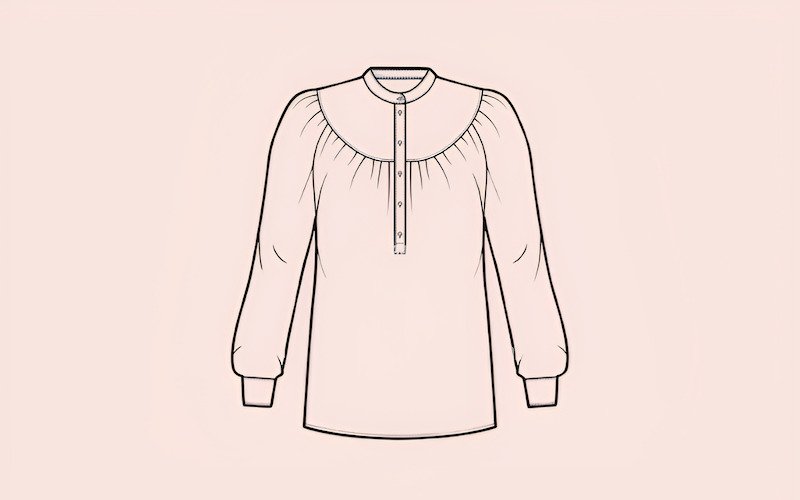
1.2 Improving comfort and movement
The improved structure and fit provided by a yoke also contribute to greater comfort. A well-made yoke allows for better garment movement. You will feel less pulling or tightness. This is especially true around the shoulders for shirts or around the hips for skirts and pants.
The yoke helps the garment follow your body’s shape as you move. This allows the garment to fit comfortably by distributing any stress across the fabric.
1.3 A place for style
Yokes are not purely functional; they can also serve as significant apparel design features. Designers use yokes to add style to clothes. Here are some examples of yoke styling:
- Using a different fabric for the yoke. For example, a blouse might have a lace yoke, or a denim shirt could have a contrasting yoke fabric like corduroy.
- Using a different color for the yoke.
- Adding special details like decorative stitching (common on Western shirts), embroidery, pintucks (small, ornamental tucks in fabric), or ruffles to the decorative yoke.
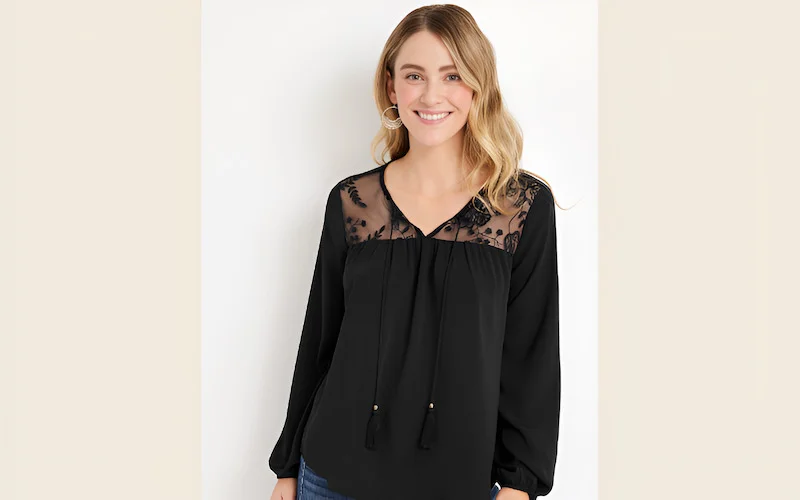
2. Where can you find yokes? common examples
Now that you know what a yoke does, let’s look at where you usually find them.
2.1 Shirts and blouses
Yokes are very common in shirts and blouses.
Back yoke:
The shirt yoke is typically located across the upper back, just below the collar, connecting the back of the shirt to the shoulders. This is sometimes called a shoulder yoke on a shirt.
Front yoke (less common):
A front yoke on a blouse or shirt is less common than a back yoke but can be found on certain styles. It is positioned on the front part of the shoulders. It helps shape the front of the garment.
2.2 Skirts and dresses
Yokes are also found on skirts and the skirt part of dresses.
Hip yoke:
A skirt or dress yoke is a shaped piece at the top of the skirt, situated around the hips or waist. It can sometimes be called a midriff yoke. The yoke on a skirt helps the skirt fit smoothly over the hips. Then, the main skirt fabric, which might be gathered or pleated, can flow down. This creates a smooth line from the waist or hip to the fuller part of the skirt.
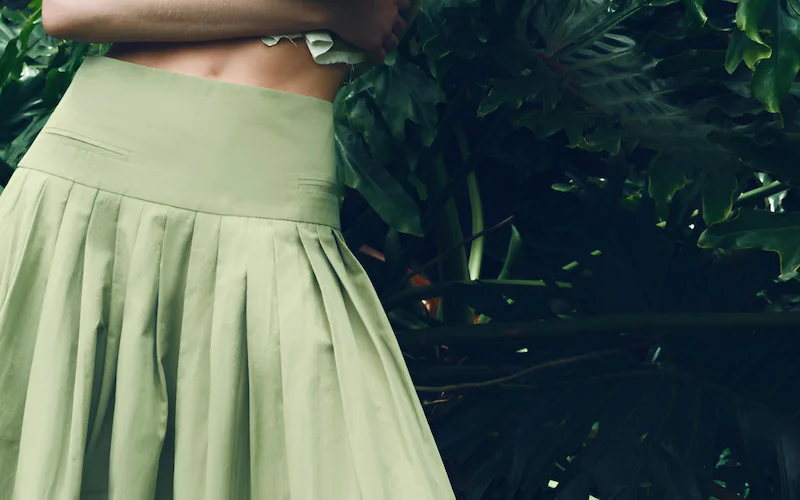
2.3 Pants and trousers
Many pants and trousers also have yokes.
Back yoke:
A back yoke is also common on pants, particularly jeans, where it’s found on the back below the waistband. This back panel on pants helps them fit better around the seat and hips, giving them shape. On jeans, it is often V-shaped or curved. This shaping improves how the pants fit over the curve of your backside.
2.4 Other garments
Yokes can also be found on other types of clothes. Examples include yokes in jackets, yokes in coats, and some kinds of children’s clothing. They do similar jobs in these garments: providing shape, support, and sometimes style.
3. Types of yokes: a quick look
Yokes can be made in different ways. Here’s a quick look at some common types of yokes found in dressmaking.
3.1 One-piece vs. two-piece yokes
Back yokes on shirts can be cut as one single piece of fabric. This is a one-piece yoke. It is simpler to make.
Alternatively, a yoke can be two separate pieces sewn together down the center back. This is a two-piece yoke or split yoke. A two-piece yoke can:
- Offer a slightly better, more contoured fit across the shoulders.
- Allow fabric patterns like stripes or checks to be matched perfectly at the center back seam.
This is often a detail in higher-quality shirt yoke construction.

3.2 Straight vs. shaped yokes
The bottom edge of the yoke, where it joins the main part of the garment, can have different shapes.
- A straight yoke has a bottom edge that is a straight line. This is common.
- A shaped yoke can have a bottom edge that is curved (either inwards or outwards), pointed (like a V-shaped yoke, common on Western shirts or the back of jeans), or scalloped.
The yoke shape is mostly a design choice that affects the style of the garment.
4. How to spot a yoke on your clothes
It’s easy to identify a yoke on clothing once you know what to look for.
4.1 Look for seams
A yoke is usually a separate piece of fabric sewn onto the main garment. So, the easiest way to spot it is to look for the seams on the yoke. These are the stitch lines that attach it.
Look for a horizontal seam across the upper back of a shirt. Or look for a seam around the hip area of a skirt before it widens. These seams are where the yoke is joined, with the seam allowance (the hidden part that joins fabric pieces) tucked inside. Seams are the key sign of a separate yoke piece.

4.2 Check key areas
Remember the common places where yokes are found (as discussed in Section 2). To find a yoke, check these areas:
- The shoulders and upper back of shirts and blouses are common locations (key to knowing where the yoke is on a shirt).
- The top part of skirts, around the hip area.
- The back of pants or jeans, just below the waistband.
The yoke’s location on a garment is typically in these spots because of their job in shaping and design.
4.3 Feel the fabric (sometimes)
Sometimes, the yoke might be made of a different fabric or have a different texture. This is not always the case, but it can be a clue. For example, you might see a denim jacket with a corduroy yoke, showing a contrasting fabric yoke. A shirt might have a smooth lining fabric for the inner yoke.
The yoke’s material can be the same as, or contrast with, the garment body. The direction of the fabric threads (fabric grain) might also run differently on the yoke compared to the main garment. This can sometimes be a visual or textural clue to spot a yoke fabric difference.
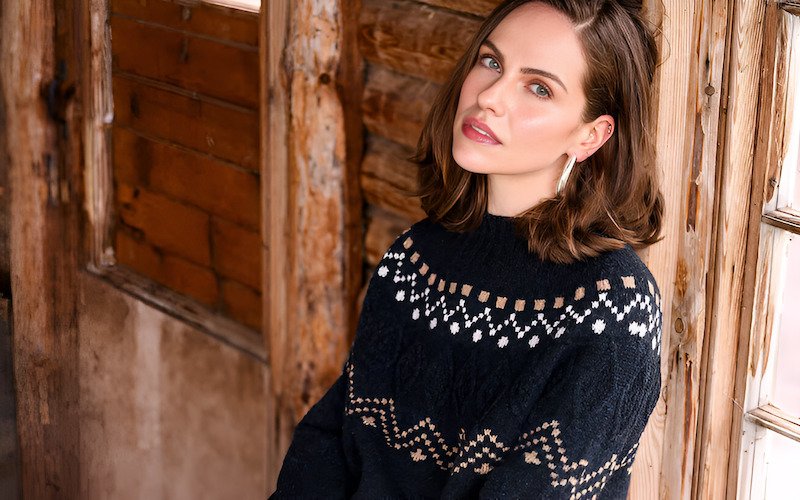
5. Yokes and your brand: a place for details
If you design or sell clothes, the yoke area is more than just structure. It offers a great opportunity for branding.
5.1 The yoke as a branding spot
The inside neck yoke of shirts, blouses, and jackets is one of the prime branding locations on apparel. Why is this a good spot? It is highly visible when the garment is on a hanger. People also see it when trying on clothes or even when worn if the collar is open. Strategic label placement on shirt yokes ensures your brand tag is easily noticed.
5.2 Why labels matter here
Labels in the neck yoke are important for two main reasons:
- Comfort: The label must not be scratchy or irritating because it touches the skin. Comfortable neck labels are key.
- Brand Visibility & Information: The label shows your brand name, logo, size, and sometimes care instructions.
Packlove can supply different types of labels perfect for this area. Consider soft woven labels (a label made by weaving threads together, like on clothing necklines). You could also use smooth printed satin labels. For ultimate comfort, heat transfer labels (a label applied to fabric using heat and pressure, often tagless) are a great choice.
Many brands seek custom labels for the neck yoke to enhance their items’ distinctiveness. A comfortable, well-placed label significantly improves customer perception, whether it’s a woven label for a shirt, a printed satin label for apparel, or a heat transfer label for clothing.

5.3 Thinking about labels for your yokes
If you create or design clothing, think carefully about the yoke area for branding. At Packlove, we help brands choose the best labels for clothing yokes.
For example, for brands prioritizing supreme comfort, especially for items like t-shirts or activewear, we often recommend Packlove’s heat transfer labels. These tagless labels are super soft. They blend right into the fabric and stop any chance of a scratchy tag.
For a more traditional or premium feel on dress shirts or jackets, a high-definition woven label from Packlove can beautifully showcase your brand logo with fine detail. A well-chosen label reinforces your brand identity. It also shows you care about detail and comfort. Consider the fabric of your garment when choosing neck labels – a lightweight fabric might need a lighter label.
6. Frequently Asked Questions (FAQs)
Here are some common questions about yokes in clothing.
Is a yoke always on the outside of a garment?
Answer: Mostly, yes. The main structural yoke is usually on the outside. However, sometimes there’s an inner yoke or a yoke facing (a similar piece used to finish an edge). This is often for lining or a cleaner finish, especially in jackets or higher-quality shirts.
Why do men’s shirts often have a two-piece back yoke?
Answer: A two-piece back yoke benefit includes a better fit and drape across the shoulders. It also allows for precise matching of fabric patterns like stripes or checks for a more polished look. This construction detail is often why dress shirts feature a two-piece yoke.
Can a yoke be decorative?
Answer: Absolutely! Yokes can be a great design feature. Decorative yoke examples include using contrasting fabrics, different colors, embroidery, pintucks, or ruffles. It’s a common way of styling with yokes.
What does “yoke” mean in sewing patterns?
Answer: In sewing patterns, “yoke” refers to the actual yoke sewing pattern piece(s) you cut from fabric to make that part of the garment. Understanding this piece is very important for anyone sewing clothes. Understanding this piece is crucial for garment construction, as the yoke is a key pattern component.
Explore more:
Now you have a better understanding of garment yokes. A yoke is a key piece of fabric in many clothes. It gives shape, adds comfort, and can be a style element. It’s a fundamental part of how a garment is made and fits. They improve fit, comfort, and design—and offer a perfect spot for brand labels. If you’re building a clothing brand, don’t overlook the yoke.
Want to learn more about garment design and branding? Visit Packlove to explore helpful articles and discover custom label solutions for your fashion line. From woven labels to heat transfer options, Packlove has everything to help your brand stand out.






